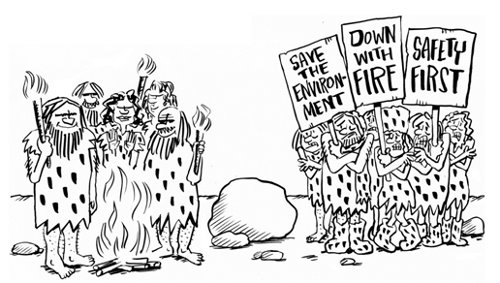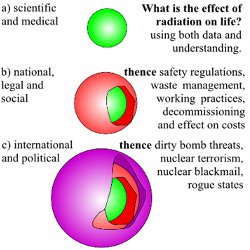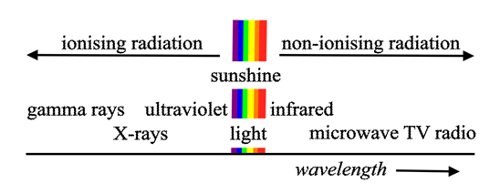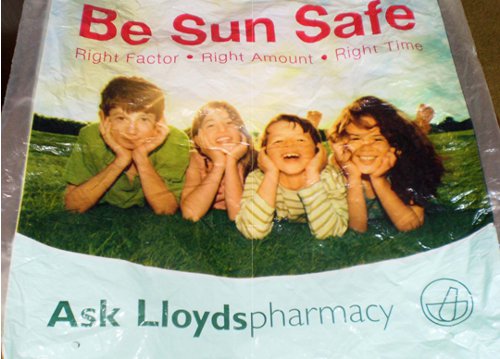The great enemy of the truth is very often not the lie – deliberate, contrived and dishonest – but the myth – persistent, persuasive and unrealistic. Too often we hold fast to the cliches of our forebears. We subject all facts to a prefabricated set of interpretations. We enjoy the comfort of opinion without the discomfort of thought. John Fitzgerald Kennedy
Public acceptance of new technologies
To support a sizeable population, civilisation needs energy and mutual trust as well as food and water. Both of these have been damaged by official and public reactions to what happened at Fukushima Daiichi in 2011, but the basis for these reactions is fundamentally unsound.

The final confrontation with the Environmental Anti Fire Party,
perhaps 125,000 BC
Advertisement
Originally man relied for energy on the digestion of food like all animals, but at a historic moment he began to domesticate fire as a source of external energy for lighting, cooking and heating his home. Although this was a dangerous step, it was essential to civilisation. No doubt the environmentalists of those days objected and had a strong case, but they had to accept that the benefits outweighed the dangers, provided education and training in the use of fire was given to everybody including children.
At the start of the 20th Century a similar decision was made to use mechanised traffic. Nobody denied that there were places of great danger but again the solution was education and training, and from a young age everybody learnt to avoid these dangers. Modern society would have been severely hampered if fire had not been brought into the home or if we were still worrying about further restrictions on road traffic - or even ruling it out.
Today, in a similar debate about the use of nuclear energy, the risks are far less than those of fire or traffic, as shown by the accident at Fukushima, but the required public education and training has never been given and primitive fear persists.
Accident at Fukushima Daiichi
On 11 March 2011 and the days following there was a natural disaster, an unnecessary panic and a self-inflicted social disaster. An exceptional earthquake generated a tsunami responsible for over 18,000 deaths. Neither the tsunami nor the quake damaged any nuclear reactors in Japan, but at the Fukushima Daiichi plant the ancillary diesel generators were destroyed so that the emergency power then failed. As a result the reactors overheated and radioactivity was released from the fuel assemblies into the cooling water and also into the atmosphere when the pressure was vented to avoid a rupture. Outside the reactor the vented hydrogen exploded chemically and this was seen on video around the world. Unlike Piper Alpha and Deep Water Horizon this accident killed no one immediately and, as will be explained, no late casualty from the radiation is expected. Nevertheless, political authorities and media worldwide, with an understanding of nuclear matters informed more by Hollywood than science, panicked. The imagined dangers of the worst possible spooked public opinion and caused a serious breakdown of trust in science and, more widely, in authority and society in general. This has had serious economic consequences in Germany, Japan and many other countries. Just at the time when the dangerous effect of fossil fuels on the environment has begun to be appreciated, nuclear energy, the sole reliable solution, is being scaled back. Locally in Japan itself large scale evacuation, both voluntary and compulsory, has destroyed many communities and over 1000 people have died from the extreme stress caused. Food supplies have been condemned and businesses ruined.
Questions raised
These official reactions have been damaging and without benefit. They were an attempt to calm the public response that still recoils at the mention of the words nuclear or radiation. Instilled by the propaganda of the Cold War this reaction can only be defused through long term re-education. In this article we make a start by asking two questions:
How dangerous to life is nuclear radiation?
How can we build public trust in the answer?
Advertisement
The first is a purely scientific and medical question that can be answered with evidence and also understanding of the how and why. These must fit together to leave no doubt. Actually this is a well trodden path, for research and experience with radiation goes back well over a hundred years. Knowing whether it is dangerous to life (shown symbolically by the green sphere below) we can answer all the consequential questions (shown by the red sphere). For example, worries about nuclear waste should only be important in so far as nuclear radiation is exceptionally dangerous. Concerns at an international level are symbolised by the violet sphere. For instance, nations are only open to black mail by a terrorist group or rogue state if the related threats frighten the public of the nation. In fact today, a dirty bomb would be a far greater threat to public order than to health.
|
<
|
 |
The second question is more difficult. How is it possible to create trust, especially if it has been lost previously? One approach is to think of a similar problem and study how that has been tackled successfully. For example, banks must create trust in the currency need everyone in society to value their grubby pieces of paper, the bank notes. How do they do it? Some carry pictures of kings, queens or presidents while others use images of famous scientists or literary figures as symbols of trust that everybody respects. Since some of these have a natural connection with radiation and the nuclear story we have a possible way forward.
In the right hand diagram above are four scientists who command public confidence.
Marie Curie, physicist, chemist, pioneer radiologist, who wrote Nothing in life is to be feared, it is to be understood.
Charles Darwin, pioneer naturalist, geologist, student of divinity, who also witnessed and described the major Chilean earthquake and tsunami of 1835.
Florence Nightingale, nursing pioneer and early statistician, who wrote How very little can be done under the spirit of fear.
Adam Smith, economics pioneer and philosopher, who wrote Science is the great antidote to the poison of enthusiasm and superstition.
Their example shows how study, personal experiences of life, common sense and fearlessness can be used to build trust and confidence. They were all remarkably broad in their skills and would not have seen themselves as narrow experts of the kind sought out by today's press for an instantly quotable opinion.
Personal confidence comes slowly with familiarity, education and thinking matters through. In Japan everyone knows what to do in the event of an earthquake and tsunami – they learn it at school from a young age. On 11 March they did not wait for orders from above – they put into action what they had learnt. So that, although there were 500,000 people in the area subsequently inundated, all but 18,800 reached safety. This was a real achievement in contrast to the reaction to the arrival of radioactivity. The public had understood that nothing should go wrong with nuclear – absolute safety was assured. So when it seemed that the impossible had happened, there was panic. Reference to higher authority evoked political reaction rather than scientific guidance. Heightened fear encouraged talk of absolute safety – but that is impossible because nature always has the ability to overpower by force majeure. Then after more than two and a half years the disarray continues and the accident is still referred to as a radiation disaster although there have been no casualties at all. But you cannot have Hamlet without bodies!
Understanding radioactivity is not difficult and with a little instruction most high school students could calculate the following by multiplying three or four simple numbers:
Anyone would have to eat more than five tonnes of food described as contaminated [100 Bq per kg, as at April 2012] over a period of three months to get a dose as large as one whole body CT scan – and that is quite harmless. Condemning such food is ridiculous because eating so much is impossible, and so the regulation is a waste of time and money.
In April 2011 TEPCO announced that it had intentionally discharged into the ocean 11,500 tons of water contaminated by 10,000 Bq per litre and it said that this was both 100 times the regulation level [100 Bq per litre, at that time] and also perfectly safe. This sounds contradictory but both statements are true! Calculation shows that drinking nothing but this water for three months would give the same dose as two CT scans.
In addition the extra CO2 emission and cost of closing the power plants have had a serious effect on the atmosphere and the economy. These are caused solely by political fear, and that continues, it seems.
Familiar radiation

The radiation spectrum
In fact everyone experiences such radiation – it is found in more familiar contexts than nuclear power. The diagram above shows the spectrum of radiation with the rainbow of light radiation at the centre. To the right there is non-ionising radiation - the only effect this has on living tissue is to heat it, and you can feel that long before it does any harm. To the left is ionising radiation that can break molecules apart, including the sensitive biological ones like DNA. First there is ultraviolet (UV) and then X-rays and gamma rays. The main difference between them is that X-rays and gamma rays penetrate the skin while UV does not.
Sunshine includes important amounts of UV as well light and heat radiation in the infra red. Like all forms of ionising radiation sunshine can kill living cells in the short term and may result in cancer later in life. We learn to enjoy the benefits of the sun and take care to avoid sunburn and skin cancer - and we teach children about it too. Simple advice to the family may come from a doctor or a neighbourhood pharmacy as shown on the plastic carrier bag illustrated below. It is true that all risk might be avoided by taking summer vacations in a dark hole in the ground, only emerging by starlight, but such vacations are not popular. An international committee on sun bathing set up under the United Nations would be ignored by most people. Gamma rays and X-rays - call it nuclear radiation - are no different from UV in principle. The burns and cancer that they cause may be deeper in the body but skin cancer is no less dangerous. So the cry it's nuclear! is purely cultural, with no scientific basis.

Living, loving and laughing with UV radiation -- a shopping bag with sensible advice about radiation for families
This is the first in a two part series on the risks and benefits of nuclear power. The second can be read by clicking here.
The author is a member of the SARI group, Scientists for Accurate Radiation Information http://radiationeffects.org/ This article is based on an invited lecture given at the Second AGORA Conference, Tokyo. and at the British Chamber of Commerce in Japan, 8 and 9 Dec. 2013. A more extended discussion with references may be found in the book Radiation and Reason available from http://www.radiationandreason.com together with other recent articles in Kindle, ePub, Japanese and Chinese editions, also available from Amazon.